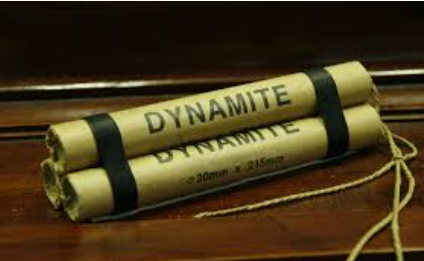Understanding quem inventou a dinamite is essential not only for history buffs but also for those interested in chemistry, explosives, and innovation. The invention of dynamite changed the world by revolutionizing industries like mining, construction, and warfare. This explosive compound, known for its massive impact, was the brainchild of a man whose legacy goes far beyond the chemical reactions he mastered.
In this comprehensive article, we’ll explore who invented dynamite, how it was developed, its effects on society, and why this invention remains significant to this day.
Quick Data Table: Who Invented Dynamite
| Aspect | Details |
|---|---|
| Main Keyword | Quem inventou a dinamite |
| Inventor | Alfred Nobel |
| Nationality | Swedish |
| Date of Invention | 1867 |
| Invention Name | Dynamite |
| Primary Component | Nitroglycerin with diatomaceous earth (kieselguhr) |
| Industry Use | Mining, construction, demolition, military |
| Legacy | Founder of the Nobel Prizes |
| Wikipedia Link | Alfred Nobel – Wikipedia |
🧪 Quem Inventou a Dinamite: Alfred Nobel, The Inventive Genius
The question “quem inventou a dinamite” has a direct answer: Alfred Nobel, a Swedish chemist, engineer, and inventor. Born in 1833, Nobel had a passion for chemistry and innovation. During his lifetime, he registered 355 different patents, but none were as transformative—or controversial—as dynamite.
From Nitroglycerin to a Stable Explosive
Before dynamite, nitroglycerin was known for its explosive potential but was dangerously unstable. Nobel’s key contribution was discovering how to stabilize this volatile compound by combining it with diatomaceous earth, creating a paste that could be safely transported and handled.
In 1867, Alfred Nobel patented this invention, naming it “dynamite,” derived from the Greek word dynamis, meaning power.
⚙️ The Development and Commercialization of Dynamite
After inventing dynamite, Nobel quickly recognized its commercial value. He set up manufacturing plants around the world and used his invention to revolutionize various industries.
Industrial Applications of Dynamite
-
Mining: Made excavation faster and more efficient.
-
Construction: Allowed tunnels, roads, and dams to be built more quickly.
-
Demolition: Enabled the controlled removal of large structures.
-
Military: Although not initially intended, it was later adapted for warfare.
The Ethical Dilemma
Nobel’s invention was both praised and condemned. On one hand, it advanced infrastructure development. On the other, it was later used in warfare, a fact that reportedly haunted him. A false obituary once labeled him the “merchant of death,” prompting Nobel to rethink his legacy—leading to the creation of the Nobel Prizes.
🧬 Synonyms & Related Terms for “Quem Inventou a Dinamite”
To help readers understand the topic more holistically, here are some related terms and synonyms that naturally fit within this article:
-
Inventor of dynamite
-
Creator of explosives
-
Alfred Nobel biography
-
Origin of dynamite
-
History of explosives
📚 Historical Context of Explosives Before Dynamite
Prior to Nobel’s invention, black powder (gunpowder) was the primary explosive. However, it lacked the strength and control dynamite provided. The invention of dynamite marked the beginning of modern high explosives, paving the way for other compounds like TNT and plastic explosives.
🔥 Impact of Dynamite on Modern Society
Even today, the effects of dynamite are visible in various fields:
-
Mining companies rely on it for safe, deep excavations.
-
Civil engineering projects like bridges and tunnels utilize controlled explosions.
-
Search and rescue missions sometimes use small explosives for access.
Despite newer alternatives, dynamite remains a vital tool in controlled demolition and excavation.
🧠 Psychological and Cultural Impact of the Invention
Understanding quem inventou a dinamite goes beyond chemistry—it touches on psychology, philosophy, and culture. Nobel’s internal conflict over the uses of his invention led to one of the most prestigious humanitarian initiatives in the world: the Nobel Prizes.
This irony—that the inventor of one of history’s most destructive tools is also responsible for rewarding peace and intellectual achievement—is a major reason the question of who invented dynamite continues to fascinate scholars and laypeople alike.
🌍 International Recognition of Alfred Nobel
Nobel is recognized globally not just for dynamite, but for his larger legacy. His foundation, the Nobel Foundation, awards annual prizes for achievements in:
-
Peace
-
Literature
-
Chemistry
-
Physics
-
Medicine
-
Economic Sciences (added later)
His work has been immortalized in literature, film, and even in popular culture, often symbolizing the duality of invention: creation and destruction.
🛡️ Is Dynamite Still Used Today?
Yes. While safer and more advanced explosives have replaced dynamite in many applications, it is still used in certain industries. Its effectiveness, affordability, and power continue to make it a go-to choice in developing regions and specific mining operations.
📌 FAQs About Quem Inventou a Dinamite
❓ Who exactly invented dynamite?
Alfred Nobel, a Swedish chemist, invented dynamite in 1867 by stabilizing nitroglycerin with an absorbent material.
❓ Why did Alfred Nobel invent dynamite?
Nobel wanted a safer alternative to nitroglycerin, which was highly unstable. He aimed to create an explosive that could be used more safely in construction and mining.
❓ Was dynamite originally intended for war?
No, it was designed for industrial use, particularly in construction and mining. However, it was later adopted for military purposes.
❓ What is dynamite made of?
Classic dynamite consists of nitroglycerin, diatomaceous earth, and a small amount of sodium carbonate to stabilize the mixture.
❓ Is Alfred Nobel the founder of the Nobel Peace Prize?
Yes. After his death in 1896, his fortune funded the Nobel Prizes, including the Peace Prize, to promote peace and advancement in various fields.
❓ Is dynamite still legal today?
Yes, but it is tightly regulated. Only licensed professionals can handle and use dynamite for approved purposes.
📑 Conclusion: Why It Matters Who Invented Dynamite
Knowing quem inventou a dinamite gives us more than just a name—it reveals a story of innovation, ethical responsibility, and lasting legacy. Alfred Nobel’s creation changed the face of industrial engineering while raising important questions about how human inventions shape our world.
From mines and mountains to scientific breakthroughs and peace treaties, the legacy of dynamite and its inventor continues to ripple through time. By understanding its origins, we better appreciate not just the explosive power of a chemical compound—but the equally powerful choices of the man behind it.

